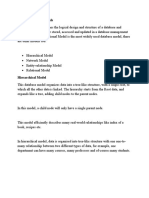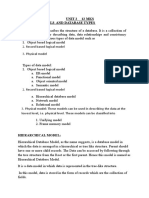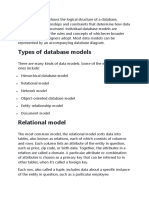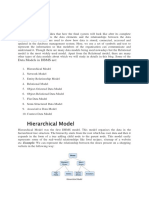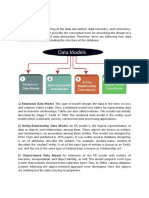0% found this document useful (0 votes)
19 views3 pagesData Models
The document discusses four common data models: hierarchical, network, entity-relationship, and relational. The hierarchical model organizes data in a tree structure, while the network model extends this to allow multiple parents. The entity-relationship model divides objects into entities and attributes and relates them. The relational model, introduced by Codd in 1970, organizes data in tables and maintains relationships through common fields.
Uploaded by
its me LofyCopyright
© © All Rights Reserved
We take content rights seriously. If you suspect this is your content, claim it here.
Available Formats
Download as DOCX, PDF, TXT or read online on Scribd
0% found this document useful (0 votes)
19 views3 pagesData Models
The document discusses four common data models: hierarchical, network, entity-relationship, and relational. The hierarchical model organizes data in a tree structure, while the network model extends this to allow multiple parents. The entity-relationship model divides objects into entities and attributes and relates them. The relational model, introduced by Codd in 1970, organizes data in tables and maintains relationships through common fields.
Uploaded by
its me LofyCopyright
© © All Rights Reserved
We take content rights seriously. If you suspect this is your content, claim it here.
Available Formats
Download as DOCX, PDF, TXT or read online on Scribd
/ 3


